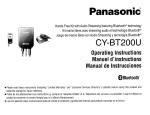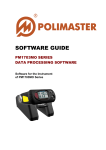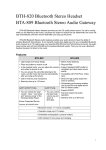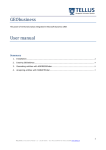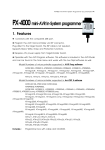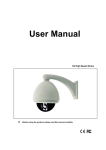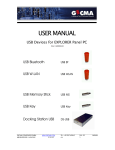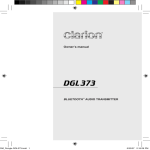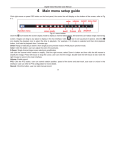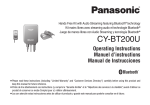Download Planet Technology BT-200U Network Card User Manual
Transcript
Networking & Communication USB Bluetooth Adapter BT-200U User’s Manual Copyright Copyright (C) 2003 PLANET Technology Corp. All rights reserved. The products and programs described in this User ’s Manual are licensed products of PLANET Technology, This User’s Manual contains proprietary information protected by copyright, and this User’s Manual and all accompanying hardware, software, and documentation are copyrighted. No part of this User’s Manual may be copied, photocopied, reproduced, translated, or reduced to any electronic medium or machine-readable form by any means by electronic or mechanical. Including photocopying, recording, or information storage and retrieval systems, for any purpose other than the purchaser's personal use, and without the prior express written permission of PLANET Technology. Disclaimer PLANET Technology does not warrant that the hardware will work properly in all environments and applications, and makes no warranty and representation, either implied or expressed, with respect to the quality, performance, merchantability, or fitness for a particular purpose. PLANET has made every effort to ensure that this User ’s Manual is accurate; PLANET disclaims liability for any inaccuracies or omissions that may have occurred. Information in this User’s Manual is subject to change without notice and does not represent a commitment on the part of PLANET. PLANET assumes no responsibility for any inaccuracies that may be contained in this User ’s Manual. PLANET makes no commitment to update or keep current the information in this User ’s Manual, and reserves the right to make improvements to this User’s Manual and/or to the products described in this User ’s Manual, at any time without notice. If you find information in this manual that is incorrect, misleading, or incomplete, we would appreciate your comments and suggestions. CE mark Warning The is a class B device, In a domestic environment, this product may cause radio interference, in which case the user may be required to take adequate measures. Trademarks The PLANET logo is a trademark of PLANET Technology. This documentation may refer to numerous hardware and software products by their trade names. In most, if not all cases, these designations are claimed as trademarks or registered trademarks by their respective companies. Revision User’s Manual for PLANET USB Bluetooth Adapter: Model: BT-200U Rev: 1.0 (January 2003) Part No. EM-BT200U ii TABLE OF CONTENTS CHAPTER 1 INTRODUCTION ...................................................................................... 1 BT-200U Features.................................................................................................. 1 Package Contents ................................................................................................. 1 CHAPTER 2 INSTALLATION ........................................................................................ 2 Software Installation ............................................................................................. 2 Software Un-installation ....................................................................................... 4 Hardware Installation............................................................................................ 5 Setup Diagnostics ................................................................................................. 6 CHAPTER 3 BLUETOOTH SOFTWARE ...................................................................... 8 About Bluetooth Software.................................................................................... 8 Description of Bluetooth Software Icons ........................................................... 9 CHAPTER 4 BASIC OPERATION............................................................................... 11 Search for Bluetooth Devices ............................................................................ 11 Pair........................................................................................................................ 12 How to use the service of File Transfer ............................................................ 13 CHAPTER 5 CONFIGURATION.................................................................................. 14 General ................................................................................................................. 14 Accessibility......................................................................................................... 15 Discovery ............................................................................................................. 16 Information Exchange ........................................................................................ 16 Local Services ..................................................................................................... 17 Client Application................................................................................................ 18 Hardware .............................................................................................................. 19 Version Info.......................................................................................................... 21 Notifications......................................................................................................... 21 APPENDIX A SPECIFICATION ................................................................................... 23 i Chapter 1 Introduction 1 This USB Bluetooth Adapter, BT-200U, is specifically designed to plug into an available Universal Serial Bus port connecting to a desktop or laptop PC. It allows you to make short-range wireless connections between Bluetooth devices such as cellular phones, personal digital assistants (PDA), and desktop and notebook computers. BT-200U uses radio transmission, voice and data are thus transmitted almost immediately. Bluetooth transmission ensures both protection from interference and secures data transfers. It helps people share and access the information that's important to them more easily. Link your notebook with your handheld, mobile phone, printer and other Bluetooth devices within your personal area network (PAN) via a secure short-range wireless radio link. Get rid of all those hassle cables and automatically share documents, browse the Internet and synchronize calendars, address books and more. BT-200U Features Ø Follows world wide standard which compatible to other Bluetooth devices Ø Bluetooth Manager Utility eases the difficulties of configuration and management Ø Various services provided: Virtual Serial Port, Dial-up Networking, Fax, File Transfer, Information Exchange, Information Synchronization, and Network Access Ø Connection protection and data security enhanced mechanism Ø Most popular OS support: Windows 98SE, ME, 2000, XP Ø Up to 8 devices Point-to-MultiPoint topology expands your PAN coverage Package Contents The following items should be included: • USB Bluetooth Adapter x 1 • USB Adapter Cable x 1 • CD-ROM (includes Driver, Utility, Manual) x 1 • Quick Installation Guide x 1 If any of the above items are damaged or missing, please contact your dealer immediately. . 1 Chapter 2 Installation 2 Software Installation Note: The Bluetooth Software should be installed well prior to the hardware installation. 1. Insert the CD-ROM into the CD-ROM drive to initiate the autorun program. Once completed, a menu screen will appear as follows: 2. To install the Bluetooth software, click on the "Bluetooth Software" hyperlink to activate the installation procedure for the application program. If the above screen is not shown, you can start the installation as follows. • Click on Start Menu/ Run. • Enter “D:\Utility\setup.exe” in the appeared box, where “D” is the letter of your CD-ROM drive. • Click on “OK” button. 3. On the Welcome screen, click the Next button. 4. When the License Agreement screen is displayed, read the License Agreement, then click the radio button to the left of “I accept the terms in the license agreement” and click the Next button. 2 Installation 5. On the Device Information screen, enter the required information: Device Name—other Bluetooth-enabled devices, when inquiring about devices within radio range, will see this user-configured device name. The name can be changed after the installation process through the Bluetooth Software Configuration Panel. Device Type—click the down arrow 6and choose Desktop or Laptop from the drop-down list. The device type can be changed after the installation process through the Bluetooth Software Configuration Panel. Click the Next button. 6. On the Destination Folder screen, click the Change button to browse to a new destination folder for the Bluetooth software. Otherwise, click the Next button to accept the default folder. 7. The InstallShield Wizard is ready to install the Bluetooth software. If you need to review or change any settings, click the Back button. Click the Cancel button to exit the Wizard. Otherwise, click the Install button 3 Broadband Router User Guide 8. Click OK at the following message (only for Windows 2000/XP installation). 9. The Installing Bluetooth Software screen displays the installation progress. If prompted to insert the Windows CD, do so and follow the on-screen instructions. 10. When finished, click Finish to end the Installation Wizard. 11. Remember to restart your computer to have the new configuration take effect. Software Un-installation 1. In Windows, go to Start →Settings→ Control Panel→ Add or Remove Programs. 2. Select Windcomm Bluetooth Software… and click the Remove button. 4 Installation Hardware Installation Note: The hardware installation should be only performed when the software is well installed. Precaution Before the installation, make sure the USB port exists in your computer and is enabled. To check this, go to My ComputeràControl Panel àSystem. Open the Device Manager tab. If the Universal Serial Bus controller device is found, it means your USB port is installed and enabled. If not, either no USB port is installed or the USB bios is not properly enabled. In this case, consult your computer dealer for USB support. Getting Hooked Up 1. Locate the USB host port of your system. Align the USB connector (the thinner end) of the USB adapter toward the USB host port, push evenly and steadily until it is seated. 2. Plug your BT-200U into the thicker end of the USB adapter cable. Connects to the USB host port 5 Broadband Router User Guide 3. As soon as the device is properly plugged to your computer, Windows will automatically detect the device and prompt the following message. Select “Install the software automatically (Recommended)” And press Next to continue. 4. Select “Continue Anyway” with the following message. 5. Press Finish to complete the hardware installation. Setup Diagnostics Once the software is well installed, your computer should prompt a Bluetooth icon on the bottom right corner. You may right click to set up the configuration. 6 Installation Select Hardware. Check if USB Bluetooth device is on the devices list as below. If yes, it means your BT-200U is well installed. 7 Chapter 3 Bluetooth Software 3 About Bluetooth Software In order to exchange data, two Bluetooth devices must establish a connection. Before a connection is established, one device must request a connection with another. The second device accepts (or rejects) the connection. The originator of the request is known as the client. The device that accepts (or rejects) the request is known as the server. Many Bluetooth devices can act as both client and server. A client Bluetooth device runs a software program that requests a connection to another device as part of its normal operation. For example, the program may request a connection to a remote computer, a printer, or a modem. Becoming a Bluetooth client normally requires an action by the device operator, such as an attempt to browse a remote computer, print a file, or dial out on a modem. Every Bluetooth device that provides a service must be prepared to respond to a connection request. Bluetooth software is always running in the background on the server, ready to respond to connection requests. Most Bluetooth-enabled devices have the capability to act as: Ÿ A Bluetooth server—these devices provide one or more services, such as access to the Internet, to other Bluetooth devices. Ÿ A Bluetooth client—these devices use the service(s) provided by Bluetooth servers. Bluetooth Software provides: Ÿ Clients with the means: ¨ To locate other Bluetooth devices in the immediate vicinity (inquiry) ¨ Discover the services that those devices offer (discovery) ¨ Connect to, use, and disconnect from those services. Ÿ Servers with the means to include/exclude individual services in the list of services they provide to clients. Ÿ Extensive security, including: ¨ Authorization ¨ Authentication ¨ Encryption. Bluetooth Software supports: Ÿ Windows 98SE (Second Edition). Ÿ Windows ME (Millennium Edition) Ÿ Windows 2000. Ÿ Windows XP Professional Ÿ Windows XP Home Edition. The services supported by Bluetooth Software are: Ÿ Bluetooth Serial Port—establishes a Bluetooth wireless connection between two devices. The connection may be used by applications as though a physical serial cable connected the devices. Ÿ Dial-up Networking—allows a Bluetooth client to use a modem that is physically attached to the Bluetooth server. 8 PC Configuration Ÿ Fax—allows a Bluetooth client to wirelessly send a fax using a device that is physically attached to the Bluetooth server. Ÿ File Transfer—establishes a Bluetooth wireless connection that allows your computer to perform file system operations on another Bluetooth-enabled device—browse, drag/drop, open, print, cut/copy, paste, delete, rename, etc. Ÿ Information Exchange—establishes a Bluetooth wireless connection between two devices so that they can exchange personal information manager data such as business cards, calendar items, email messages, and notes. Ÿ Information Synchronization—establishes a Bluetooth wireless connection between two devices and uses the connection to synchronize Personal Information Manager data between the two devices. Ÿ Network Access—establishes a Bluetooth wireless connection between the client and a server that is physically connected to the Local Area Network. If the client has permission (user name and password for the LAN), the wireless connection can be used as if the client were hardwired to the LAN. Please note that not all Bluetooth servers provide all of these services. To find out the services provided by a Bluetooth device: 1. On the client, in the Folders pane of My Bluetooth Places, select Entire Bluetooth Neighborhood. 2. In the right pane of Entire Bluetooth Neighborhood, right-click anywhere except on a device name and select Refresh from the pop-up menu. 3. In the Folders pane of My Bluetooth Places, right-click a device and select Discover Available Services from the pop-up menu to update the available services list. The available services will be displayed in the right pane of My Bluetooth Places. Description of Bluetooth Software Icons Bluetooth icons provide at-a-glance feedback about a device or service's status by changing color. Device icons are blue in color with yellow accents in their "normal" state and green with yellow accents in their "connected" state. Devices that are paired with this computer display a "check mark" in the upper-left portion of their icon. 9 Broadband Router User Guide Service icons are gray or yellow in color (or gray with yellow accents) in their "normal" state. In the "connected" state the primary color of the icon (gray or yellow) changes to green. Errata for Windows XP device icons in their lower-right corner. Icons for services that are not available have a red "X" Services may be unavailable because they are in use or because the necessary hardware (such as a modem for Dial-up Networking) is not installed. 10 PC Configuration Chapter 4 Basic Operation 4 For best performance, we recommend that the Bluetooth devices you are setting for transferring files should be within a range of 10 meters of each other. Before you start communicating with a Bluetooth device, you need to: 1. Search Bluetooth devices in the vicinity. 2. Pair your PC with the device – you do this by adding the device to a list of paired devices in your PC. Search for Bluetooth Devices In Windows 2000 1. In the Folders pane of My Bluetooth Places, Double-click Bluetooth→Search for devices. 2. Select Entire Bluetooth Neighborhood in the right pane. The device name(s) will show up if this computer has used the Bluetooth service. In Windows XP 1. In the Folders pane of My Bluetooth Places, Double-click Bluetooth→ Search for devices. 2. Select Search for devices in range in the left pane. The device name(s) will show up if this computer has used the Bluetooth service. 11 Broadband Router User Guide Pair Pairing is the process of associating Bluetooth devices with each other so that they connect as soon as they get within range of each other. You can initiate the pairing between two Bluetooth devices from your own PC or you can accept a request for pairing from the other device. 1. Right click the device that you just found. Select Pair Device. 2. The Bluetooth Passkey Request screen will be present. Enter the Passkey to authenticate device identity and encrypt data. 3. Meanwhile, the remote device that is requested for connection will prompt the following message for you to enter the passkey. Click the prompted message to enter the passkey. 4. Enter a passkey (up to 16 digits) for both your PC and for the other device. 12 PC Configuration After the pairing procedures are completed, you may start using the local services that a Bluetooth server is capable of providing, which includes Bluetooth Serial Port, DialUp Networking, Fax, File Transfer, Information Exchange, Information Synchronization and Network Access. How to use the service of File Transfer The File Transfer service allows one Bluetooth device to perform file operations on the specified or default File Transfer directory (and the folders and files it contains) of another Bluetooth device. On the Server PC, 1. From the Bluetooth Configuration panel, on the Information Exchange tab, enter the directory you want to share the folders with the other device. Click OK. On the Client PC, 1. In the Folders pane of My Bluetooth Places, select Entire Bluetooth Neighborhood. 2. In the right pane of Entire Bluetooth Neighborhood, right-click anywhere except on a device name and select Refresh from the pop-up menu. 3. In the Folders pane of My Bluetooth Places, right-click the device you already set to transfer files with and select Discover Available Services from the pop-up menu. 4. Double-click Public Folder to expand that folder. If there are additional folders inside the expanded folder then those additional folders may have to be expanded. 13 Chapter 5 Configuration 5 General You may determine the device properties and basic system security settings on the General tab of the Bluetooth Configuration Panel. Identity Computer Name Computer type enter a unique name to identify this computer to other Bluetooth devices in the vicinity; this field cannot be left blank. select either Desktop or Laptop from the drop-down menu to help identify this computer to other Bluetooth devices in the vicinity. Security High Medium requires Bluetooth devices to authenticate (enter a Personal Identification Number (PIN)) before allowing a connection to be established. Your computer and the connected Bluetooth device will exchange data using encrypted links. the default setting—security is configured at the service-level. Service level security means that each individual service must have its security settings (Authentication, Authorization and Encryption) set independently. Note: If the security mode is “Medium” and service-level security is not configured, any Bluetooth device will be able to discover your computer and use its services. 14 Advanced Configuration Accessibility In the Accessibility tab of the Bluetooth Configuration Panel, you will be able to specify which remote devices may access this computer. Security settings configured in the General, Local Services, and Client Applications tabs may also affect which devices have access to this computer. To allow other devices to discover this computer: select "Let other Bluetooth devices discover this computer" to permit remote Bluetooth devices to find and report this computer. If "Allow No devices to connect" (below) is selected, this option is not available. From the Allow drop-down-menu, you may select to control the types of devices that are allowed to connect to this computer. no remote devices are permitted to initiate a connection No devices to connect with this computer. However, this computer can still initiate connections (as a client) with remote Bluetooth devices. all remote devices are permitted to connect to this comAll devices to connect puter. Only paired devices to only devices that have been paired with this computer are allowed to connect to it. connect Only devices listed only the listed devices are allowed to connect to this computer (see next section for details of adding and below to connect deleting devices). 15 Broadband Router User Guide Discovery In the Discovery tab of the Bluetooth Configuration Panel, you can determine: 1. whether your computer looks for other Bluetooth devices automatically, 2. how often it looks and, 3. what type of devices it looks for. Perform a periodic Search for Devices When "Look for other Bluetooth devices" is selected, Bluetooth Software automatically searches for devices every “X” minutes. X is an integer from 1 to 60. To change the time between auto inquiries, highlight the existing time and enter the new time. Note: When My Bluetooth Places is first opened it performs an initial automatic search for devices even if "Look for other Bluetooth devices" is not enabled. Determine which devices will be reported Bluetooth Software can show devices that you do not need to access. The options are: Report all Bluetooth devices Report only selected Bluetooth devices Select the desired option from the drop-down list. Information Exchange The Information Exchange service provides a way to send and receive Microsoft Outlook items to and from another Bluetooth device, such as a Personal Digital Assistant or notebook computer. 16 Advanced Configuration The settings on the Information Exchange tab of the Bluetooth Configuration Panel configure: File Transfer My Shared Directory: the directory configured in this section is the highest-level directory to which a remote Bluetooth computer has access. This directory and its sub directories are displayed in the remote device's My Bluetooth Places. Click the Browse button and navigate to the directory that will be used as My Shared Directory. Send Business Card My Business Card: the path to the directory on this computer that contains your electronic business card. Select the "Send Business Card on Request" option to allow remote devices to obtain your business card. Click the Browse button and navigate to the directory that contains your business card. Receive Business Card My Inbox Directory: the path to the directory on this computer where inbound Personal Information Manager items such as Business cards, Notes, Calendar entries and Email Messages will be saved. Select the types of items you wish to accept by placing a checkmark in the appropriate boxes, and then click the Browse button to navigate to the directory where they should be saved. Select the "Save Objects in Personal Information Manager" option to save incoming objects directly in the PIM. When this option is selected, the path specified in “My Inbox Directory” is not used. Local Services The settings on the Local Services tab of the Bluetooth Configuration Panel determine the configuration of the services provided by your computer to remote devices. Each service can be configured individually for security, name, and other settings. 17 Broadband Router User Guide The Local Services tab also includes options to add and delete user-defined serial services. Bluetooth Software Local Service names are: Ÿ Bluetooth Serial Port Ÿ Dial-Up Networking Ÿ Fax Ÿ File Transfer Ÿ Information Exchange Ÿ Information Synchronization Ÿ Network Access Client Application Network Access The Network Access service permits a Bluetooth client to use a Local Area Network connection that is physically attached to another Bluetooth device (the server). 18 Advanced Configuration Possible Network Access servers include: 1. Bluetooth-enabled computers that have a hardwired Ethernet connection. 2. Stand-alone Bluetooth Network Access Points. The Bluetooth server must be specifically configured to provide the Network Access service. After a Bluetooth device is configured as a Network Access server it cannot act as a Network Access client without being re-configured. Hardware The Hardware tab of the Bluetooth Configuration Panel provides basic information about the Bluetooth hardware installed on this computer and access to the Advanced Settings dialog box. 19 Broadband Router User Guide Devices: Name name of the device, e.g., My Bluetooth Device Type type of the device, e.g., USB. Device Properties: Manufacturer the name of the company that manufactured the device selected in the Devices section of this dialog box. Firmware Revision the manufacturer's firmware version number. Device Status indicates that the device is operating properly or that there is a problem/conflict. Device Address the Bluetooth Device Address (BDA or BD_Addr) programmed into this device when it was manufactured. HCI Version the version number of the Bluetooth Specification that the Host Controller Interface complies with. HCI Revision the revision number of the Bluetooth Specification that the Host Controller Interface complies with. LMP Version the version number of the Bluetooth Specification that the Link Manager Protocol complies with. LMP Sub Version the sub-version number of the Bluetooth Specification that the Link Manager Protocol complies with. Advanced displays the Advanced Settings dialog box, which allows you to select the country code and transmission power settings. This option is not available on all systems . Hardware Advanced Settings Dialog Box When available, this dialog box is reached from the Hardware tab of the Bluetooth Configuration Panel. Depending on the country in which the hardware is sold and/or in which it will be used, the Advanced button may not be present. From this dialog box you can set the: Country Code: Maximum Transmission Power: North America, Europe (except France), and Japan France and China High Medium Low Ÿ Click the Apply button to implement the changes. A dialog box appears with notification that the Bluetooth device attached to this computer must be reset before the change(s) will take effect. Ÿ Click the Yes button to reset the Bluetooth device now—all open Bluetooth connections will be closed. 20 Advanced Configuration Ÿ Click the No button to save the changes—the changes will be applied the next time the Bluetooth device is reset or restarted. Version Info The Version Info tab of the Bluetooth Configuration Panel displays the name and version number of the software components of Bluetooth Software. There are no options can be configured on this tab. Notifications The Notifications tab of the Bluetooth Configuration Panel lets you associate a sound (Windows *.wav file) with specific Bluetooth events. 21 Broadband Router User Guide Sounds can be associated on an individual basis with several events, including: 1. When a PIN code is required 2. When a remote device attempts to access: ¨ Files on this computer ¨ A Bluetooth port ¨ The Dial-up network service ¨ The LAN Access service ¨ The Fax service. 3. When a remote device attempts to send: ¨ Synchronization information. ¨ Information items To associate a sound with a Bluetooth event: 1. From the Bluetooth Configuration Panel, select Notifications tab. 2. In the Notify column of the Events list, select the check box associated with the event. 3. In the Sound area of the Notifications tab, click the Browse button and navigate to the sound file (*.wav) to be used for notification. To preview the sound file, click the play (>) button. 4. Click the OK button to close the Bluetooth Configuration Panel. Note: The sound will not play, even though it has been assigned, unless the Notify check box is selected. 22 Appendix A Trouble Shooting A Q1: CANNOT CONNECT TO A PAIRED DEVICE: A1: Paired devices are always displayed in My Bluetooth Places, even if the remote device is out of range or not powered up. Verify that the remote member of the pair is within radio range and powered up and then attempt the connection again. Q2: CANNOT DISCOVER SERVICES ON AN UN-PAIRED REMOTE DEVICE: A2: The remote device may not be powered up or may be out of range. § Verify that the remote device is powered up. § Verify that the remote device is in Connectable mode (Bluetooth Configuration Panel > Accessibility tab). § Perform a Search for Devices to verify that the device is within range. Q3: DIAL-UP NETWORKING SERVICE DOES NOT START: A3: The Dial-up Networking service will not start unless a properly configured modem is attached to the server. § Verify that the modem is usable as a local device from the server. § In the Bluetooth Configuration Panel, Local Services tab, double-click the Dialup Networking service: ü Click the down arrow in the Modem field and select the modem that will be used to dial out. ü Click the OK button. ü Click the OK button to close the Bluetooth Configuration Panel. Q4: HOW DO I DETERMINE THE BLUETOOTH DEVICE ADDRESS (BDA) OF MY HARDWARE DEVICE? A4: In the Bluetooth Configuration Panel, on the Hardware tab, in the Devices section, select the device you want to determine the address of. In the Device Properties section of the dialog box, the fourth entry, Device Address, is the BDA of the selected Bluetooth. Q5: HOW DO I DETERMINE THE VERSION NUMBER OF THE BLUETOOTH SPECIFICATION THAT THE HOST CONTROLLER INTERFACE (HCI) COMPLIES WITH? A5: In the Bluetooth Configuration Panel, on the Hardware tab, in the Device Properties section, the fifth entry provides Bluetooth Specification compliance information for the Host Controller Interface. The sixth entry contains the Specification Revision information for the Host Controller Interface, if appropriate. 23 Broadband Router User Guide Q6: HOW DO I DETERMINE THE VERSION NUMBER OF THE LINK MANAGER PROTOCOL (LMP)? A6: In the Bluetooth Configuration Panel, on the Hardware tab, in the Device Properties section, the seventh entry provides Link Manager Protocol version number information. The eighth entry contains the Link Manager Protocol sub-version number information, if appropriate. Q7: HOW dO I FIND INFORMATION ABOUT THE BLUETOOTH HARDWARE ATTACHED TO MY COMPUTER? A7: In the Bluetooth Configuration Panel, select the Hardware tab Q8: HOW DO I TEST A NETWORK ACCESS CONNECTION? A8: If the client is hardwired to the LAN, unplug the hardwired connection to ensure that the test checks the wireless connection rather than the hardwired connection. If the server has access to the Internet, open a browser on the client and connect to the World Wide Web. You may also Ping the server from the DOS prompt. Q9: WHY DO I GET AN UNKNOWN PORT MESSAGE WHEN I ATTEMPT TO USE A BLUETOOTH SERIAL PORT? A9: The “Unknown Port” error message usually means an attempt was made to connect a port that was in use. Additional Bluetooth Serial Ports can be added if they are required. 24 Appendix C - Specifications B Appendix B Specification Standard Bluetooth v1.1 Interface USB v1.1 (Type A) Frequency band 2.4~2.4835GHz unlicensed ISM band Data rate Up to 723Kbps Modulation method GFSK (Gaussian Frequency Shift Keying) Spread spectrum FHSS (Frequency Hopping Spread Spectrum) Operating voltage 5V from connected USB port TX output power Class 2 Operating distance Up to 10 meters in open space Topology 8 devices Point-to-MultiPoint Receiver sensitivity Better than -70dBm @ 0.1% BER Compatible OS Windows 98SE/ME/2000/XP Security provided Pairing, encryption, authentication LED indicator Power: Orange Operating temperature 0°C ~ 45°C Storage temperature -10°C ~ 70°C Humidity 5 ~ 90% (non-condensing) Power requirement 5V DC, 86mA Regulatory compliance FCC, CE 25






























